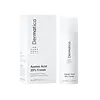What's inside
What's inside
 Key Ingredients
Key Ingredients

 Benefits
Benefits

 Concerns
Concerns

No concerns
 Ingredients Side-by-side
Ingredients Side-by-side

Water
Skin ConditioningGlycerin
HumectantButyrospermum Parkii Butter
Skin ConditioningPrunus Amygdalus Dulcis Oil
Skin ConditioningGlyceryl Stearate Se
EmulsifyingPrunus Armeniaca Kernel Oil
MaskingOlea Europaea Fruit Oil
MaskingCetyl Alcohol
EmollientStearic Acid
CleansingOryza Sativa Bran Oil
EmollientSodium Levulinate
Skin ConditioningSodium Anisate
AntimicrobialSodium Hyaluronate
HumectantAloe Barbadensis Leaf Juice
Skin ConditioningRetinyl Palmitate
Skin ConditioningGlyceryl Caprylate
EmollientAmorphophallus Konjac Root Extract
HumectantArgania Spinosa Kernel Oil
EmollientTocopherol
AntioxidantXanthan Gum
EmulsifyingSodium Ascorbyl Phosphate
AntioxidantFerulic Acid
AntimicrobialCitrus Nobilis Peel Oil 0.205%
MaskingWater, Glycerin, Butyrospermum Parkii Butter, Prunus Amygdalus Dulcis Oil, Glyceryl Stearate Se, Prunus Armeniaca Kernel Oil, Olea Europaea Fruit Oil, Cetyl Alcohol, Stearic Acid, Oryza Sativa Bran Oil, Sodium Levulinate, Sodium Anisate, Sodium Hyaluronate, Aloe Barbadensis Leaf Juice, Retinyl Palmitate, Glyceryl Caprylate, Amorphophallus Konjac Root Extract, Argania Spinosa Kernel Oil, Tocopherol, Xanthan Gum, Sodium Ascorbyl Phosphate, Ferulic Acid, Citrus Nobilis Peel Oil 0.205%
Water
Skin ConditioningAzelaic Acid
BufferingPropanediol
SolventSqualane
EmollientDimethicone
EmollientGlycerin
HumectantGlyceryl Stearate
EmollientPEG-75 Stearate
Phenoxyethanol
PreservativeCetyl Alcohol
EmollientTocopheryl Acetate
AntioxidantAcrylates/C10-30 Alkyl Acrylate Crosspolymer
Emulsion StabilisingSodium Lauroyl Lactylate
EmulsifyingSodium Hydroxide
BufferingCeramide NP
Skin ConditioningCeramide AP
Skin ConditioningPhytosphingosine
Skin ConditioningCholesterol
EmollientCarbomer
Emulsion StabilisingXanthan Gum
EmulsifyingCeramide EOP
Skin ConditioningWater, Azelaic Acid, Propanediol, Squalane, Dimethicone, Glycerin, Glyceryl Stearate, PEG-75 Stearate, Phenoxyethanol, Cetyl Alcohol, Tocopheryl Acetate, Acrylates/C10-30 Alkyl Acrylate Crosspolymer, Sodium Lauroyl Lactylate, Sodium Hydroxide, Ceramide NP, Ceramide AP, Phytosphingosine, Cholesterol, Carbomer, Xanthan Gum, Ceramide EOP
 Reviews
Reviews

Ingredients Explained
These ingredients are found in both products.
Ingredients higher up in an ingredient list are typically present in a larger amount.
Cetyl Alcohol is a fatty alcohol. Fatty Alcohols are most often used as an emollient or to thicken a product.
Its main roles are:
Though it has "alcohol" in the name, it is not related to denatured alcohol or ethyl alcohol.
The FDA allows products labeled "alcohol-free" to have fatty alcohols.
Learn more about Cetyl AlcoholGlycerin is already naturally found in your skin. It helps moisturize and protect your skin.
A study from 2016 found glycerin to be more effective as a humectant than AHAs and hyaluronic acid.
As a humectant, it helps the skin stay hydrated by pulling moisture to your skin. The low molecular weight of glycerin allows it to pull moisture into the deeper layers of your skin.
Hydrated skin improves your skin barrier; Your skin barrier helps protect against irritants and bacteria.
Glycerin has also been found to have antimicrobial and antiviral properties. Due to these properties, glycerin is often used in wound and burn treatments.
In cosmetics, glycerin is usually derived from plants such as soybean or palm. However, it can also be sourced from animals, such as tallow or animal fat.
This ingredient is organic, colorless, odorless, and non-toxic.
Glycerin is the name for this ingredient in American English. British English uses Glycerol/Glycerine.
Learn more about GlycerinWater. It's the most common cosmetic ingredient of all. You'll usually see it at the top of ingredient lists, meaning that it makes up the largest part of the product.
So why is it so popular? Water most often acts as a solvent - this means that it helps dissolve other ingredients into the formulation.
You'll also recognize water as that liquid we all need to stay alive. If you see this, drink a glass of water. Stay hydrated!
Learn more about WaterXanthan gum is used as a stabilizer and thickener within cosmetic products. It helps give products a sticky, thick feeling - preventing them from being too runny.
On the technical side of things, xanthan gum is a polysaccharide - a combination consisting of multiple sugar molecules bonded together.
Xanthan gum is a pretty common and great ingredient. It is a natural, non-toxic, non-irritating ingredient that is also commonly used in food products.
Learn more about Xanthan Gum